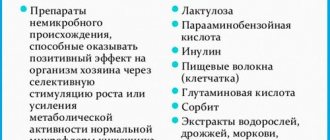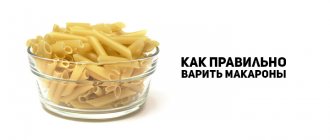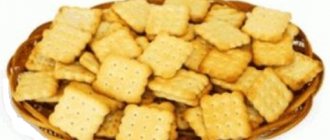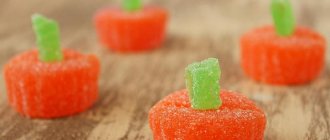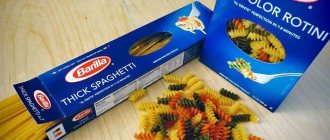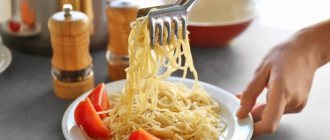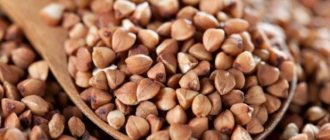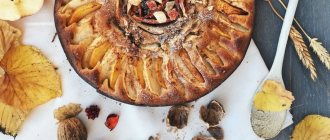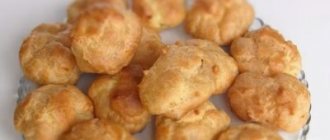How many calories can there be in pasta?
The calorie content of dry pasta is about 250-350 kcal per 100 grams, but when boiled, the number of calories is reduced. All this happens because they are overcooked. Therefore, the calorie content of boiled pasta will be significantly lower - about 150 kcal per 100 grams of product
.
If you are on a diet and want to lose weight, you should not completely give up this product, you just need to learn to control its consumption. In order to cook pasta in an acceptable quantity, take as much of it as will fit in your hand and boil it. The dry weight of pasta will be about 50 grams, respectively, in finished form it will be 100 grams, and a serving of the dish will contain only 150 kcal, which will not be so dangerous for your figure. But remember that it is better to give preference to a product made from durum wheat rather than soft, since in the first case the calorie content will be higher, and such a product contains no less carbohydrates than white bread
.
Pasta for weight loss:
And further:
How not to damage your figure:
- Choose pasta from group A (made from durum wheat). When in doubt, buy Italian-made products.
- Avoid instant noodles. Choose pasta varieties that cook for at least eight minutes.
- Cook them until they are slightly undercooked. In Russia, this option is not very common: it feels like the dish is half-baked. But in Italy it is considered standard to cook it just until al dente, when the middle of the pasta remains somewhat hard.
- Give preference to long products (spaghetti).
- Replace butter, mayonnaise, and cream sauce with light gravies. Bolognese, tomato with seafood, and vegetable sauces are suitable.
Delicious recipe! How to maintain a relationship with a man at a distance
How to cook Vermicelli dish
- Place vermicelli in boiling salted water and stir.
- When the water boils again, reduce the heat and cover the pan with a lid.
- Cook vermicelli until tender, about 10 minutes.
- Vermicelli - 250 gr.
- Water - 500 gr.
- Salt (to taste) - 0.5 tsp.
Nutritional value of the Vermicelli dish (per 100 grams):
Useful properties of products
Few people know, but pasta is not only very tasty and nutritious, but also has the following beneficial properties:
- they saturate the muscles with complex carbohydrates, which helps to quickly recover after physical activity;
- help with intestinal dysbiosis, remove toxins and harmful substances, all thanks to the presence of large quantities of fiber in durum wheat;
- An amino acid such as tryptophan promotes restful sleep and improves mood;
- improves metabolism, making human skin and legs look healthy.
The advantage of pasta based on durum grains
Pasta made from such varieties of wheat does not contain large quantities of fat and vegetable protein, like those made from soft varieties. They also include the following components:
- fiber in large quantities;
- complex carbohydrates;
- amino acids;
- vitamin B1.
The price will be slightly different from the others, but they are not harmful to the figure, and are even good for health.
Such a low calorie content of this type of pasta is due to the fact that it contains complex carbohydrates that have a minimal glycemic index.
. Carbohydrates are broken down quickly, and the calories themselves do not accumulate, turning into hated fat deposits.
The calorie content of products based on durum wheat is about 150 kcal per 100 grams in finished form. To make the dish low-calorie and tasty, add olive oil to it when cooking. Then it will not need to be seasoned with butter, which is fattier.
Ingredients of boiled pasta:
Vitamins:
| Vitamin: | IN 1 | AT 2 | AT 4 | AT 5 | AT 6 | AT 9 | RR | E |
| in mg. per 100 grams | 0.105 | 0.044 | 10.4 | 0.4 | 0.077 | 0.005 | 0.7 | 0.6 |
Minerals:
| Mineral: | Calcium | Phosphorus | Magnesium | Potassium |
| in mg. per 100 grams | 15 | 86 | 29 | 43 |
Delicious recipe! Pasta Salad Recipes
Products made from soft wheat contain very few healthy carbohydrates and fiber - practically nothing but empty calories. However, you shouldn’t blame flour for everything.
A 100-gram serving of any prepared pasta usually contains not 175 kcal, but much more. Where does the surplus come from? From all kinds of additives, gravies, sauces. We sometimes don’t take them into account, but the butter, cheese, and mayonnaise that we willingly flavor pasta with can turn out to be higher in calories than the main dish.
How many calories are in noodles and spaghetti
Sometimes the calorie content is also affected by the shape of the products. So, 100 grams of spaghetti contains a minimum of fat, but has a high calorie content - 345 kcal
. At the same time, boiled spaghetti can provide a person with 9 percent of the daily energy requirement.
The calorie content of spaghetti may vary depending on the cooking method. For example, 100 grams of classic Bolognese pasta contains 200 kcal, and if you cook spaghetti with seafood, then 100 kcal, respectively.
In production conditions, spaghetti is thinly pressed, and its glycemic index will be 10 points lower compared to thicker pasta.
And another version of the product - noodles, has 320 kcal per 100 grams of product
. Noodles are loved in all countries and are prepared using different types of flour. The lowest calorie noodles are made from durum cereal varieties or pea flour. It helps with dysbiosis and normalizes intestinal microflora.
And the most dietary noodles are buckwheat, whose calorie content is only 160 kcal per 100 grams. This is one of the popular Asian dishes.
The history of vermicelli
Vermicelli appeared in beautiful Italy, as did many other pasta products. The product is considered the thinnest representative of this product line. The diameter of vermicelli is only 1.4 mm. spaghettini is more voluminous. Today there are many types of vermicelli. Among them: amateur, gossamer and ordinary. They are distinguished by the thickness of the product itself. It can vary by just a few millimeters. Thus, the thinnest type of vermicelli is gossamer, which is most often added when preparing all kinds of soups and other first courses.
Despite the fact that the calorie content of noodles is 337 kcal per 100 grams, nutritionists believe that even if you consume this product too often, you can stay slim and not gain weight. The vermicelli itself does not contain a single gram of fat. It is the additives to it that you should be careful of: sauces, ketchup, gravy. Making vermicelli is very simple. You need to pour it into boiling, pre-salted water and stir regularly to avoid burning. And if you are afraid that the vermicelli will stick together, then make sure that it floats freely in the pan, and also add a little oil. The manufacturer indicates how long to cook vermicelli on the packaging.
Features of whole grain pasta
whole grain pasta on sale.
, which are made not like the others, from sifted crushed grains, but from whole ones. They include:
- B vitamins;
- antioxidants;
- iron.
The calories in such products are much less than in regular ones, about 5 times. The glycemic index is practically the same, however, such pasta will be more healthy. For dietary nutrition, such a product is simply irreplaceable.
As you can see, you don’t need to completely exclude your favorite pasta from your diet if you’re planning to lose weight. The main thing is to approach the consumption of pasta wisely, so that you can both enjoy your favorite dish and benefit your body from it.
Pasta is a common product used to make side dishes. It is believed that the product has a high calorie content, and therefore it should not be consumed during weight loss or to maintain weight if you are prone to obesity. However, knowing how many calories are in pasta
, and cooking methods to reduce calories, you can eat pasta at lunchtime without restrictions.
Pasta is a flour product, but its variety today is so great that you can find lower-calorie varieties to eat during a diet. Next, types of pasta, cooking features in order to reduce calorie content, as well as examples with recipes will be presented in detail.
Pasta is made from a dough using wheat flour and water. As a result, the product can be classified as complex carbohydrates necessary for the body due to prolonged saturation and energy production for normal life. Nutritionists do not recommend using varieties for quick cooking, but giving preference to pasta made from durum wheat. At the moment, pasta varies in composition, shape and even color.
Among the long varieties there are:
- vermicelli;
- spaghetti;
- spaghettini;
- fettuccine;
- capellini, etc.
Among the short pasta products, the following varieties are distinguished:
- tortiglioni;
- maccheroni;
- cavatappi, etc.
There are also curly varieties:
- farfalle (we call them “butterflies”);
- conchiglie (or “shells”);
- capeletti (similar to small Russian dumplings), etc.
As a result of the huge number of varieties, one can count more than 200 pasta dishes, the cooking features of which should be based on reducing calories in order to lose weight or maintain a slim body.
About the benefits of boiled pasta
Pasta is a high-carbohydrate product containing a huge amount of fiber. It cleanses the body of waste and toxins and helps speed up metabolism. Slow carbohydrates saturate the body for a long time, so you shouldn’t give up boiled pasta even on a diet.
Slow carbohydrates, which enter the human body in the form of boiled pasta, normalize blood sugar levels, causing long-term saturation. The dish can be eaten with a small amount of butter, or better yet, with sour cream sauce, to which spices and other herbs are added.
About energy value
The paste contains about 400 kilocalories in 100 g of pure product. You can learn about BZHU - the content of proteins, fats and carbohydrates - from the instructions provided on the packaging. When losing weight, you need to count the calories that come from the dry amount of pasta. When boiled, they increase in size, so it is necessary to calculate the calorie content of the finished dish carefully and correctly.
The approximate calorie content of pasta made from durum wheat and others is presented in the table.
In most cases, preference is given to Italian spaghetti, which is attractive, easy to prepare, loved by children, and provides great opportunities for preparing various dishes. They can be consumed with oil in small quantities in pure form. The calorie content of spaghetti per 100 grams is 344 kcal.
Please note: The calorie content of a dish directly depends on the additional components to the pasta. Indicators decrease if the paste is flavored with vegetable oil rather than butter. You can use sour cream sauces for taste - sour cream with finely chopped vegetables and herbs.
About choosing a useful product
In order for the paste to bring maximum benefits to the body, you need to know the rules for choosing the product in question.
For this, the following factors are taken into account:
- it is important to pay attention to the instructions, where the KBZHU is written - the content of calories, proteins, fats and carbohydrates - in pasta recommended for weight loss there should be at least 10 g of protein per 100 g;
- good pasta is sold only in packages;
- the color should not be bright - this indicates the use of dyes;
- if there are white specks on the surface, it means that the purchase is rejected - this is low-quality flour that did not dissolve during the process of kneading the dough;
- a musty smell indicates improper storage of the product - it should not be consumed;
- packaging with pasta must be a sealed transparent plastic bag (it is important to be able to independently examine the contents of the bag);
- during cooking the pasta, no foam should form on the surface, the water should be clear, without additional shades;
- the cost of a quality product is above average.
The choice of form and manufacturer is carried out at your own discretion and financial capabilities.
Please note: Pasta produced by Makfa and Barilla are especially popular. The first one is affordable for most buyers. Barilla products are somewhat more expensive. Both offer durum wheat pasta.
About cooking methods and their effect on calorie content
The news that the calorie content of fried pasta is higher than boiled pasta will not surprise anyone. But not everyone knows how to use methods to reduce performance.
Where the following features stand out:
- if you use additives in the form of spices during cooking, you can increase the calorie content of the product - even using broth instead of water noticeably changes the indicators in question;
- you need to look at the pack to find out the calorie content of the product - often even the shape of the pasta affects the indicators (for example, cones and spaghetti from the same manufacturer have different indicators);
- adding sauces, sour cream, ketchup, mayonnaise to ready-made pasta significantly increases the energy value - often 1.5 times if there are a lot of additives;
- macaroni and cheese have 2-3 times more calories than a simply cooked product;
- The energy value of fried pasta doubles if you simply use vegetable oil.
Boiled pasta without adding oil contains approximately 115 kcal per 100 g of finished product. Eating them will not cause weight gain unless you add fatty additives to the dish.
The influence of cooking method on calorie content
The calorie content of cooked pasta changes during cooking. This is influenced by the amount of water and what additives you use to add flavor and aroma to the dish. But there are also other nuances - be sure to look at the calorie content of the paste on its packaging, because depending on the brand and composition, the energy value can vary significantly.
Often, without thinking, we put something into ready-made pasta for taste and smell, for example, salt, soy sauce, seasonings, sauces, sour cream, butter, etc., without thinking about how much they increase the calorie content of the entire dish. For many this is not a problem, but there are those who watch their diet very strictly or adhere to a certain diet. That is why you should carefully monitor what and in what quantity you add to the prepared product. This is especially true for additives such as cheese or meat, because they are quite fatty and high in calories.
Find out the calorie content of pasta with butter in this article
We will tell you about the calorie content of scrambled eggs on our website.
How many calories are in your favorite borscht - with chicken, beef or pork - you will learn from the article here https://hudelkin.ru/produkty/kalorijnost-borshha-kuricej-svininoj.html
Pasta recipes
It is necessary to provide recipes for some dishes that contain pasta, but will not affect your figure.
Pasta with chicken and broccoli
This dietary dish is balanced and can be eaten for breakfast or lunch.
The cooking sequence is as follows:
- Cut the chicken fillet into cubes and place it in a heated frying pan with vegetable oil. Fry with onions and bell peppers, add broccoli and water to simmer all the products.
- While the vegetables are stewing in a saucepan, you need to boil water and pour in the pasta for cooking. Cook them for no more than 8-10 minutes.
- Place the boiled pasta in the pan with the meat and vegetables. Simmer for 10 minutes.
Serve the dish hot in its pure form. You can add fresh vegetables.
Macaroni with cream and cheese
The preparation of the presented dish is simple and is carried out in the following sequence:
- Pasta is boiled in salted water.
- At the same time, for cooking, you need to heat the cream in a frying pan or Dutch oven, add crumbled cheese. Wait for it to dissolve.
- Place the boiled horns on a plate and pour the sauce over them.
The presented dish turns out to be more high in calories, so when losing weight it is better to refrain from eating it. If you want to try something new, you can use it in small quantities in the first half of the day.
Fettuccine with seafood and tomatoes
Fettuccine is a thick noodle that replaces traditional spaghetti.
Cooking occurs in the following sequence:
- Boil the noodles until tender in salted water.
- Fry onions, tomatoes and seafood cocktail in a frying pan with vegetable oil for 10 minutes.
- Place noodles on a plate and top with a few spoons of sea cocktail with vegetables.
The recipe can be changed a little if you put the noodles in a frying pan with a sea cocktail and vegetables.
Pasta with green beans
The cooking principle is similar to the recipe described above using a sea cocktail.
Italy, or more precisely Palermo, is considered the birthplace of pasta. However, according to some sources, this dish existed back in Ancient Greece. However, the name comes from the Sicilian "maccaruni", which means "kneaded dough".
Useful properties of pasta
- They fight against dysbiosis
, remove toxins and other unnecessary substances from the body due to the high fiber content in durum wheat. It is a natural absorbent. - Improves mood, helps to get enough sleep. The secret is in the amino acid tryptophan
, which is converted into the famous “happiness hormone” - serotonin. - Complex carbohydrates saturate muscles
, restoring the body after physical activity. - They improve metabolism
and, consequently,
the condition of hair, nails and skin
. The reason is the content of B vitamins. - Prevents skin aging and the occurrence of cancer cells
thanks to vitamins E and A.
There are two types of pasta:
- Traditional
from durum or, as they say, coarse varieties of wheat and water. - Egg
- made from flour (preferably the same hard varieties) and eggs (sometimes only the white - a dietary option, in other cases - only the yolk).
There is no clear answer to the question of which pasta: egg or wheat pasta is healthier. Some argue that eggs make noodles even more saturated with nutrients. For example, selenium. Others believe that traditional pasta made from durum wheat and water is healthier in its simplicity.
Calorie content of pasta
As you can see from the table, the calorie content of boiled pasta is not high. However, numerous sauces give dishes made from them high energy value.
It is difficult to judge the calorie content of ready-made dishes, since each housewife has her own recipes. But if you want to get a healthy and wholesome dish, then use the following tips:
- The ideal addition to them is vegetables or seafood
- Instead of cream sauce, it is better to use tomato sauce with a minimum amount of oil.
- Choose the lowest fat cheese
Features of Italian pasta preparation
Rice and glass noodles
In addition to traditional pasta, two other types of pasta are also popular. These are rice noodles and funchose, which are also called glass noodles.
Rice noodles are made from rice flour. Its advantages include a high content of complex carbohydrates and a lack of fiber, which allows the dish to be classified as easily digestible. In addition, it contains 8 essential amino acids
responsible for building new cells. This makes it very popular among athletes.
Funchoza is a product made from legumes. And, therefore, it boasts a high protein content.
Rice and glass noodles do not need to be boiled
. They will be ready 15 minutes after they are poured with boiling water.
In the modern world, pasta is one of the most popular products. Today there are many varieties of them. The calorie content of pasta depends on the raw materials and manufacturing method.
Culinary recipes
Below are several dishes whose main ingredient is pasta. These dishes are easy to prepare, low in calories, but will bring great benefits to your body!
Pasta with chicken and broccoli
Ingredients:
- chicken fillet – 800 g;
- olive oil – 1 tbsp. spoon;
- broccoli florets – 2 cups;
- pasta – 1 package (400-500 g);
- finely chopped onion - half a glass;
- salt, spices - to taste.
Preparation:
Heat a frying pan over medium heat, add olive oil. Cut the chicken fillet into small cubes and fry in a frying pan until golden brown. Add onion and pre-boiled broccoli to the fillet. Add a little water and simmer everything until the onion acquires a darker (golden) color.
While the vegetables and chicken are stewing, pour water into a saucepan, bring to a boil, add the pasta and cook until tender (8-10 minutes). After which you can lay out the pasta and add chicken and vegetables there. Use salt and seasoning to taste.
Creamy macaroni and cheese
Ingredients:
- pasta – 1 package (400-500 g);
- grated hard cheese – 100-150 g;
- cream 10% - 100 ml;
- salt and spices to taste.
Preparation:
Following package instructions, cook pasta until done. Heat the cream in a small, shallow saucepan and add the grated cheese. Season with spices. Stir slowly and remove pan from heat when cheese begins to melt.
Drain the pasta in a colander, transfer it to a plate, and top with cheese and cream sauce. The dish can be decorated with finely chopped herbs.
Fettuccine with seafood and tomatoes
Ingredients:
- fettuccine (thick noodles) – 400-500 g (1 pack);
- olive oil – 2-3 tbsp. spoons;
- sea cocktail – 100-150 g;
- tomatoes – 5-6 small pieces;
- onion – half a whole or 1 small;
- greens (dill, parsley);
- salt;
- spices.
Preparation:
Place a saucepan of salted water over low heat, add the fettuccine and cook until tender, following the instructions on the package.
Add olive oil to a hot frying pan, finely chop the onion and fry until golden brown. Then finely chop the tomatoes, simmer them a little with onions and add the sea cocktail. Stirring constantly, simmer for 3-5 minutes. Place a mixture of tomatoes and seafood on the finished pasta, sprinkle with herbs and seasonings on top.
Pasta with green beans
Ingredients:
- pasta – 400-500 g (1 package);
- green beans –250-300 gr;
- tomatoes – 2 pcs.;
- garlic – 2 cloves
- olive oil – 2 tbsp. spoons;
- tomato paste – 2 tbsp. spoons;
- salt;
- ground black/red pepper.
Preparation:
In a saucepan of salted water, cook the pasta until tender, following the instructions on the package. Peel the tomatoes, cut into squares along with the garlic and simmer with olive oil over low heat for 3 minutes. Add frozen beans to tomatoes and simmer until tender. At the end, add tomato paste and seasonings and mix. Place the pasta on a plate, add beans and tomatoes on top. You can season it with soy sauce.
Boiled pasta: calorie content and composition
Pasta is made from flour and water. Depending on what kind of flour was used to make them, certain properties of the product are distinguished, including the calorie content of pasta.
Until recently, only pasta made from soft flour was common in the post-Soviet space. The calorie content of boiled pasta of this type is about 350 kcal per 100 g. In addition, they have a high glycemic index, that is, when eaten, sharp jumps in blood glucose and insulin are observed, which leads to increased appetite and the development of various chronic diseases.
The opposite of them is pasta made from durum wheat. Such products are rich in coarse dietary fiber, stabilize blood sugar levels and give a feeling of fullness for a long time.
Plant fiber in such pasta is a natural adsorbent, helps remove excess amounts of harmful substances and fats from the body, is a nutrient for valuable intestinal bacteria, and promotes normal digestion. Pasta made from durum wheat contains a large amount of vitamins B and E, minerals (iron, potassium, manganese, phosphorus) and other trace elements. In addition, the composition of proteins and carbohydrates allows them to be recommended in baby food. The calorie content of durum pasta is 213 kcal per 100 g.
It should also be noted that as part of a healthy diet, you should consume pasta made exclusively from flour and water. If we are talking about colored pasta, you need to make sure that the food colors are of natural origin (beet juice, carrots, spinach, etc.).
About pasta:
What calorie content boiled pasta has, what dietary properties it has, all this is of great interest to those who lead a healthy lifestyle and monitor their health and figure. So we will try to answer these questions in the next article.
So here it is:
What is pasta? These are products of various shapes, usually made from wheat flour. The dough is first kneaded in water and then dried in a special way. Sometimes rice or buckwheat flour is used, and other ingredients are added to the dough, for example, tomato paste, spinach, eggs. The key word here is flour. That is, the properties of pasta depend on the quality of the flour from which they are made. And we already know that there are different types of flour.
In accordance with domestic GOST, pasta is divided into three groups:
- group A – made from durum wheat flour of the highest, first and second grades;
- group B – made from soft glassy wheat flour of the highest and first grades;
- group B - made from premium and first grade wheat baking flour.
Durum wheat contains more gluten and less starch than soft wheat. Therefore, group A pasta has a lower glycemic index. In a number of countries, for example in Italy, it is allowed to produce pasta exclusively from durum wheat (and you can’t say that Italians are overweight).
Proper pasta contains virtually no fat. According to Russian standards, 100 g of dry pasta should contain 10.4–12.3 g of protein, 1.1–2.1 g of fat, 64.5–71.5 g of carbohydrates, and their energy value is 327–351 kcal . Don't be scared by these numbers. In fact, the pasta is boiled, and the daily norm is on average 50–60 g of dry pasta (150–180 g of ready-made). Thus, we eat a fairly impressive portion, but get no more than 175 kcal.
Pasta made from durum varieties has the least calorie content. They are rich in healthy sugars that help maintain constant blood glucose levels. Thanks to this, we manage to increase the intervals between meals without suffering from attacks of hunger. Pasta contains B vitamins, which are necessary for brain function, as well as for the beauty of skin and hair. Let's not forget about fiber, which helps the digestive system process foods and get rid of everything unnecessary.
